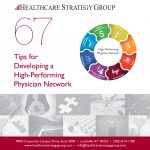 Controlling the losses on employed physician networks is the biggest immediate challenge for many of our clients. The losses have been created by the confluence of fast growth, limited investment in talent, and health care executives’ limited experience with managing physician networks.
Controlling the losses on employed physician networks is the biggest immediate challenge for many of our clients. The losses have been created by the confluence of fast growth, limited investment in talent, and health care executives’ limited experience with managing physician networks.
TIP 49 Define your dashboard.
If you are not measuring for it, there will be no improvement. With the physicians, define the key measures and manage them relentlessly.
TIP 50 Complete comprehensive operational assessments of your trouble spots.
Benchmark your practices and autopsy those that are not performing. Bring in an independent resources, whether another manager or a consultant, to help guide the improvement plan.
TIP 51 Invest in your revenue cycle.
Hospitals that try to manage this function as a single unit with the hospital’s revenue cycle are rarely successful. The divergent scale almost ensures hospital charges will get the attention. Make it a separate function!
TIP 52 Physicians should be held accountable for costs.
Part of each physician’s standards and performance goals should address practice costs. Give them the data and hold them accountable.
TIP 53 Credential providers with payers before you employ them.
Many hospital executives don’t understand this issue. If the providers are not credentialed, you cannot collect from payers and face months of losses and cash flow challenges. Start the credentialing process the day you agree to hire the physician. No exceptions!!
TIP 54 If you control 30-35 percent of the PCP community, you can leverage the payers.
Invest in primary care, then tie the negotiation of their contracts (and other specialists) to the hospital/system negotiation schedule. You will get the insurers’ attention. They may be able to compete without your hospital, but your PCPs are essential.
TIP 55 Leverage your growing care management capabilities with payers.
Talk to payers about their willingness to differentiate payments for medical homes or other care management systems. We have seen payers come to the table with other ideas, as well, such as one-sided cost sharing. If you don’t ask – you don’t get!
TIP 56 Know how many PCPs you need to support each specialist.
If you had a totally closed network, how many PCPs would be required to keep your specialists busy? This is a “must” to know, especially when building your primary care network.
TIP 57 Set a target for a positive operating margin.
To most, this is a big stretch, but model where the practice would be at peak performance, and set about moving the practice in that direction. We recommend excluding corporate allocations from this modeling.
TIP 58 Manage to ensure losses per provider decline with new additions.
As the practice grows and management matures, scale should create benefits. Put this metric on your dashboard and manage to it.
TIP 59 Recognize the physicians’ contributions to the system overall.
The most egregious mistake hospital executives make (and allow boards to make) is to pull out ancillaries and then forget that reality. Your organization must recognize these pieces of the puzzle, and the total must meet expectations on return.

